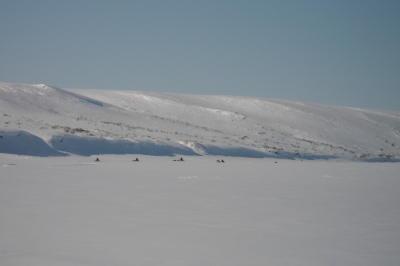21 April, 2002
We are now traveling across Alaska's arctic coastal
plain. This area is very flat and covered by many,
many lakes. In fact, about 40% of the land here is
covered by lakes. These lakes are typically small,
less than a kilometer in diameter. As we drive along,
these lakes are frozen and snow-covered, just like the
surrounding tundra. Both the tundra and lakes are so
flat that it is usually difficult to tell whether we
are driving over land or water.
These lakes are typically very shallow, with about 85%
of them being less than 2 meters deep. By the end of
winter the lake ice is about 2 meters thick. So this
means that 85% of them are frozen solid by the end or
winter. This means that 85% of the lakes probably do
not have fish in them, and that 85% of the lakes could
not be used as a winter fresh-water supply by local
residents.
When these lakes freeze solid, the bottom of the lake
ice sticks to the bottom of the lake. When the lakes
melt in the spring, this means that the ice stays
stuck to the lake bed, and there is water over the top
of the ice when it is melting. This is different from
most lakes, because ice usually floats (like an ice
cube in your glass of iced tea). So, the big visual
difference between how a normal lake melts and how
these arctic lakes melt, is that a normal lake has
white ice floating at the surface, while
the ice on these arctic Alaska lakes are a
spectacularly-beautiful green color as they melt under
the water surface.
WHERE IS MRS. CHEUVRONT ??? LET'S PLOT!!!
Latitude: 70.47963 North
Longitude: 157.41816 West
The wind was calm today. The cold felt refreshing.
Cold is manageable. Wind is hurtful. We performed 6
abbreviated tundra/lake pairs today. One class 2
chemical sampling was performed. Our machines jostled
and bumped along the tundra and across the lakes. We
were in coastal plains area. The lakes are numerous
connected by rivers. The caribou roam in small herds
across the snow covered landscape. The team is tired.
We have traveled over 760 miles. We have some 80+
miles to travel to Barrow. We reached Atqasuk which
sets along the Meade River. It sits outright and
alone in this white world. This is the first
civilization since Ambler. Tonight we are refreshed
resting in a house in Atqasuk. The team has done
extremely well. It feels good to have showers and a
warm place to sleep after 2 weeks in the cold Arctic
field.
Temperature min: -28 degrees Celsius
Temperature max: -16 degrees Celsius

One of the many icy, snow covered lakes that we have crossed.
Contact the TEA in the field at
.
If you cannot connect through your browser, copy the
TEA's e-mail address in the "To:" line of
your favorite e-mail package.
|
